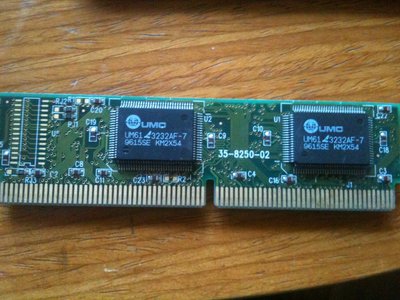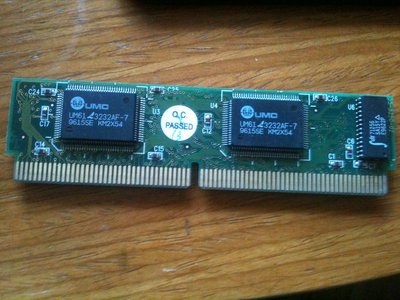FGB, Your experience is helpful, in that it gives clues as to which
lines of investigation are worth following up.
So, from your experience & Turbomans pics, specifically;
http://s636.photobucket.com/user/gijoe25th/me … C07851.jpg.html
I deduce that the ENTIRE bank 1 (U28-31) is populated by
FAKE cache chips, evidenced by the laughable printing (looks
as if a rubber stamp were poorly applied), the solid plastic (no
circular stamp marks which should be present if the chip had
base and top joined to enclose actual 'silicon' chip inside) and
their general poor finish compared to the real cache chips
present in bank 0.
Regarding chips TM TE 11256; there is findable a TM manufacturer,
(actually 'TM Tech' , {they put 'TECH' word on two lines}) which is
'Taiwan Memory Technology Incorporated'. Although I found no
webpage datasheet for that specific chip designation (WaybackMachine
included), and so can't state factually that that is an actual designation,
I believe it is likely to be so, as TM company reports from circa early 90's
cite revenue from product SRAM 256K, further said to be 32Kx8
(and no reference could be found as to any 64Kx8 SRAM chips, even to
year 2000; http://web.archive.org/web/20000407053327/htt … .tw/product.htm ).
(Also, in present day, their SRAM line is only 32Kx8.)
Your wording seemed to indicate to me that you had deduced that
all the 256K chips were wrongly labelled, as maximum of only 128KB
is all you have been able to get through experimentation with the
applicable jumpers. (In regard to the OP's apparently V1.4 board, at
least) how about this possiblity: we should see this;
Total Cache......Bank 0.......Bank 1......TAG Ram..Pieces
...................(U21-24).....(.U28-31)....(U20)
.......256K.......32Kx8........32Kx8.......32Kx8.....9
but because bank 1 is entirely fake chips, what we are getting is this;
½ of 256Kreal..32Kx8real....fake.........32Kx8.....5 actually real chips
because all the bank 1 chips are fake.
Wouldn't four real 256K (labelled) chips (ie, only in bank 0), also give your
observed results of 128KB L2?
Turboman - 'tweren't such a 'Big Mistake', I'm sure others reading this
wish they had your boards... 😀
(especially as then we could test if traces to bank 1 are real, and
if the 'fake chip' pins have no continuity to other pins inside the fake
chip, could easily solder four 256K chips onto the top of the fake
chips, and test {with appropriate changes to the jumpering} if L2
capacity of 256KB is achieveable.)















